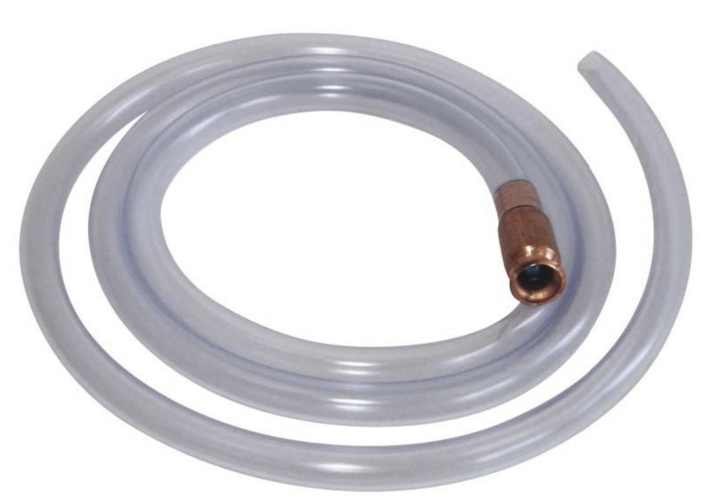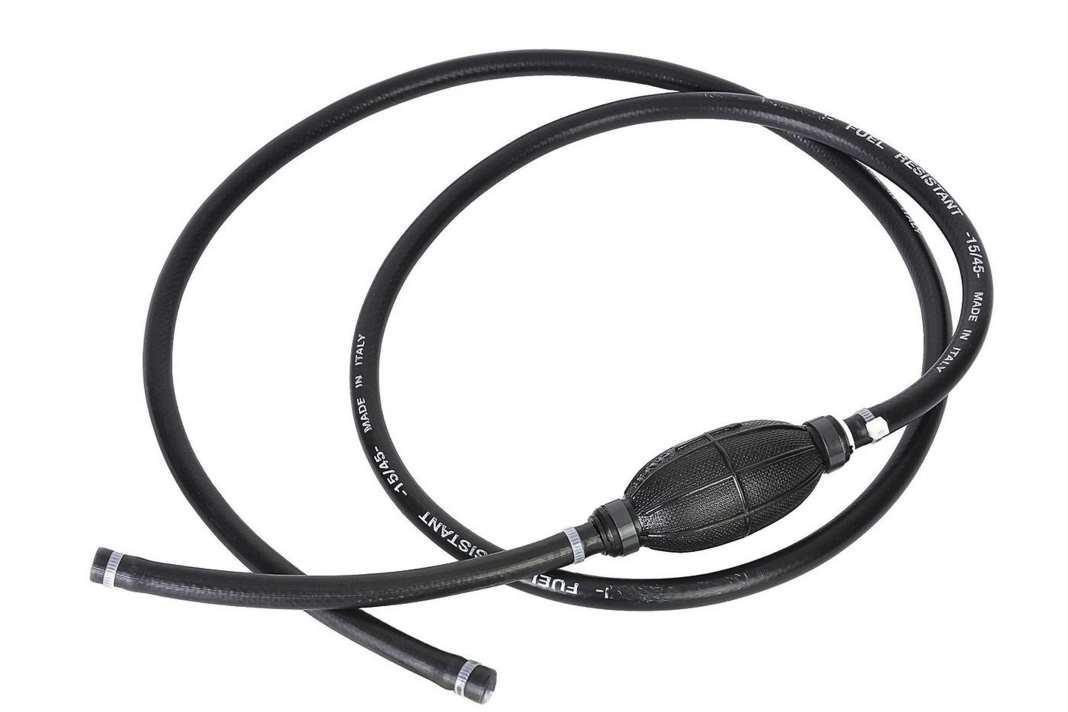
Emptying the diesel tank should be avoided at all costs. This is because dirt particles from the bottom of the tank or air can enter the engine circuit with the last drops - with the corresponding consequences. Refuelling in good time prevents this. However, there is not always a refuelling station nearby.
Sometimes you get caught out at sea when you unexpectedly use more fuel than expected. It is therefore better to check your fuel level regularly. If in doubt, head for the nearest boat refuelling station with a half-full tank. Then the diesel tank will be topped up in no time at all. And, above all, without spilling. The fuel nozzles are equipped with special tank stop systems that prevent dripping as soon as you let go of the nozzle handle.
However, anyone who has ever refilled diesel or petrol from a canister into the boat or dinghy tank knows that this usually does not happen without splashing. It goes without saying that such a reserve tank should always be on board for emergencies. And if you want to drive with special fuels such as HVO100 climate diesel, you usually have no choice but to buy the fuel at the petrol station anyway.
Which canisters are permitted?
The first question that arises is which canisters are suitable and permitted. According to the law, they must be approved for fuels. When transporting in the car or in the back box, make sure that the containers are tightly closed and secured against slipping and falling over. Also ensure sufficient ventilation.
A maximum of 240 litres of fuel may be transported in the car. The individual container must not hold more than 60 litres. And before refuelling your boat from a canister, you should definitely ask the harbour master whether this is permitted at the berth. It goes without saying that you should make sure that not a drop of diesel or petrol gets into the water.
How does the fuel get into the boat tank without spilling?
Most people make do with a funnel and lots of rags. This is because splashes can hardly be avoided, especially at sea. To prevent environmental damage, every drop that spills should be wiped up.
It is better to use a special decanting system. Some work with the help of gravity. This means that the canister with the petrol must be higher than the tank filler neck. This is usually not a problem with boat tanks, as the filler neck is usually recessed somewhere in the deck. With a dinghy engine with an integrated tank hanging from the stern, however, it can be complicated to position the canister high enough. Sometimes the only thing that helps is a second person holding it up.
Shaker pump, rubber bellows and co.

The most widely used is the so-called shaker pump. It consists of a transparent tube, which is available in different diameters, and a cylindrical piece at the end. Inside is a glass ball that acts as a non-return valve. The pump is easy to use: the end of the tube with the cylinder is inserted into the canister and the level in the tube rises by gently pulling it up and down. This hand movement is repeated until the fuel is "over the hill" and gravity does the rest.
Alternatively, there are filling hoses that are fitted with a pump ball. This is a rubber bellows fitted with valves that hangs in the supply line like an outboard motor with an external tank. The bellows is used to draw in the fuel by repeatedly squeezing and releasing it. As soon as the diesel or petrol has reached the highest point, gravity also helps here, i.e. the fuel flows out of the canister into the tank on its own.
You can also install a shut-off valve on the pressure side of the hose, as YACHT reader Hans Mühlbauer has done (see below). This makes it easier to regulate the fuel flow and ultimately switch it off completely.
Of course, ready-made solutions are also available to buy. For example, the "Flo n' Go" siphon pump with petrol nozzle. You have to pull the handle to pump and release it again until the diesel flows on its own. The flow can also be stopped at the petrol nozzle. To ensure that this system works properly, we recommend ordering the appropriate canisters at the same time.
Hand pump instead of electric pump
There are systems with an integrated power source and those with a connection cable for the twelve-volt battery or socket. We tested two pumps with an integrated power supply: The "Seaflo" with a rechargeable battery pumps a good twelve litres per minute. The rod-shaped "Onvaya", on the other hand, only manages six litres per minute; it is powered by two 1.5-volt batteries (mono cells).
One disadvantage of the "Seaflo" is the circumference of the pump body. With a diameter of around 33 millimetres, it does not fit into the opening of conventional reserve canisters. Practical on the other hand: The filling hose is equipped with a tank stop device. The petrol pump from "Onvaya" has a smaller pump body. With a diameter of 28 millimetres, it fits into most of the canisters we tested - although not all of them.
Pumps that are connected to an external power source are generally more powerful. On board, they are powered by the twelve-volt battery. However, it remains to be seen whether you need this on a pleasure boat. Above all, such pumps, like the "Ultimate Speed" and "Whale High Flow pump" models we tested, often have a pump body or suction basket that is too large for conventional canister openings.
The drill pump is a completely different solution: Hoses are connected to the suction and pressure lines and are inserted into the canister and the filler neck. The drill chuck is clamped onto a drive shaft and then driven by a drill or cordless screwdriver.
Canister with safety spout
A canister attachment known as a safety outlet is particularly suitable for topping up an outboard motor with an internal tank, as mentioned at the beginning of this article.z. It is normally sold in specialist shops for refuelling chainsaws. This design has a valve at the front that only opens when the tip is pressed against the edge of the tank opening. This means that nothing can go wrong when the canister is attached. The highlight, however, is that the attachment also closes automatically as soon as the fuel reaches the valve, i.e. when the tank is full. This prevents any spillages.
Another alternative is a canister with a swivelling outlet nozzle and a lever on the back, such as the Birchmeier Rapidon 6, 6 litres. When the lever is pressed, air enters the canister and a valve on the opposite side of the outlet spout is opened. However, this system does not have an automatic stop device.
Protection against tank overflow
Apart from spilling, there is always a risk of the tank overflowing when transferring petrol from the canister. To prevent this from happening, you can use an overflow whistle. It is installed in the hose of the petrol tank ventilation system. Its function is simple: the air flowing out of the vent during refuelling is passed through the whistle, producing a sound. When this sound stops, the tank is filled up to the whistle. However, the installation of such a whistle is time-consuming, as the vent hose must be cut at a suitable point.
Conclusion: The simplest principle is the shaker hose. However, you can't do without a cloth. The system with the pump ball and the "Flo n' Go" pump are also easy to use. If you only want to refuel from time to time, this is a good option. The attachment from the chainsaw accessories is ideal for smaller canisters, especially for refuelling small outboard motors. When buying an electric pump, make sure that the pump body or suction hoses fit into the openings of standard five to twenty-litre canisters. An alternative is the drill pump. The following applies to all systems: ensure that the pumps are approved by the manufacturer for use with fuels.
Three things you should consider before buying




Overview: Tank assist systems and accessories






Three reader tips on refuelling





